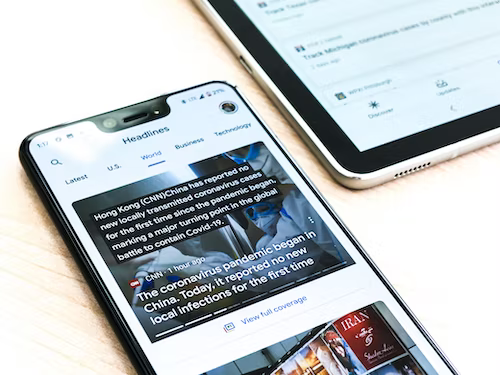On any given day, you casually come across an article or a post on the internet with a quirky title and wonder, “wow, that’s quite smartly written.” That, folks, is what we call the first impression! Such is the pull of an exciting blog title that it stays in the mind of readers long after they have read it.
Hardly a day goes by when you don’t spend a significant portion of your time searching for something on the internet. To put it more simply, you opt for google to find answers to your inquiries, from Black Friday email subject lines to the best gifts for Christmas! In significant ways, blog post titles function as the gateway to any original content, the first thing you see when searching for answers.
Why are Blog post titles important?
When you see someone or interact with them for the first time, you have a specific initial impression of them, don’t you? Similarly, when choosing an article you’d like to read, you generally opt for one with the most intriguing or informative title.
This is how first impressions generally work. Using this idea as a template, a blog post title should be formulated accordingly. Now you may wonder, “Does the content have no value?” No, we are not saying that. The content of an article is invaluable, depending on how it’s written. However, if the title is bland and non-receptive to readers, the entire range may go unnoticed!
Would you read an article with a misleading or extremely generic title? Likewise, it is vital to create headlines that engage readers and invoke a curious appeal, so they get to learn something new and are fascinated by it. In many ways, writers and readers engage in a bond of informative companionship with a reader, and just like any relationship you’re part of, there’s a certain level of trust and respect.
This respect and trust are a gateway between the readers and the writers. Additionally, on the technical side, blog post titles play a crucial role in Search Engine Optimization as they determine the amount of traffic and viewership of that article.
You’re in the right place if you are wondering how to create irresistibly click-worthy titles. Below we discuss ten practical tips for writing the perfect blog post title.
1. Learn from successful titles
It’s the order of life that the more you learn, the more you’ll be successful. This reasoning applies directly to your quest to identify the best way to write a headline title. As you are aware, countless articles on a singular topic are available on the internet. However, not every one of them is good, nor do all have a terrific and engaging headline. It’s your job to seek out popular articles and learn what makes them reader-friendly and what templates have been used for the headlines.
Some blogger outreach and marketing companies especially engage in finding the correct way to draft a headline. They perform comparative studies and identify trends that are popular on the web. Some of the most popular formulas that they use include:
- Headline numbering
- Promise headlines
- Scarcity headline
- Comparative headlines
Additionally, various mediums conduct extensive studies to figure out power words and power sentences that may rank well in searches. However, don’t try to fit these words into your headline thoughtlessly. Understand how certain words can improve your headline, not change the meaning entirely!
2. Pay attention to distinct headlines
As mentioned above, you come across many headlines daily, not just blog posts on the internet but headlines in newspapers or magazines. Most of the time, when you sit and think about a decent headline, chances are you take your inspiration from one such headline. Hence, paying attention to a good headline is always essential to know what makes it engaging.
Let’s take this headline: “10 Easy Ways to get in shape within days.” Here the entire idea is to ease the reader into the idea of fitness and working out while, at the same time, the mannerism used is to implant the idea in the head of the reader that the process will be easy. Simple and on point!
Moreover, for a good blog writing service, you can also derive inspiration from the thumbnail of YouTube videos since they are curated for maximum viewership and engagement. However, the most traditional way to improve your writing, either headlines or reports, is through diligent reading. The more you read, the better a writer you’ll become.
3. Practice writing
Just as learning makes you knowledgeable and gives you the confidence to write correctly, practicing writing regularly gives you that sharpness required to put pen to paper. The more you write, the easier it will become for you, and you’ll be able to experiment with various writing styles and tropes.
Similarly, the more blog post titles you write, the better you will be at the activity. You can start by giving yourself specific assignments and writing different blog post titles. You can also practice writing other templates and blog post titles to hone your writing skills.
You can set up challenges by giving ten to 30 minutes daily to write titles if you’re serious about becoming a good writer. While the tried and tested method of writing on paper stimulates a sense of nostalgia, there are several websites where you can hone your writing skills with added modifications. Some of the most popular ones are:
- Google Docs
- Scrivener
- Atticus
- Vellum
- Freedom
- Microsoft Word
4. Research Keywords
Now we go into the specifications of blog post title writing. Usually, when you are working on a blog, the first time you do it properly, research the topic. To make the research process more justifiable and exciting, you can also check what titles have been used and how they have generated a buzz.
Since you are trying to construct a connection with your readers, it’s always wise to understand what kind of content they prefer or the words that are most likely to resonate with them. The more earnestly you write and can create that elusive connection, the more your SEO ratings will improve.
However, it would help if you didn’t try to force keywords in your titles or the article. This will ruin your content, and your title will lose its originality if the keywords seem out of place. When it comes to keywords research, there are several tools available online that can assist you in achieving organic traffic:
- Semrush
- Soovle
- Jaaxy
- Google Search Console
- SECockpit
- Google Keyword Planner
- Moz Keyword Explorer
5. Write Multiple Blog Headlines
Blogging companies understandably have deadlines, so you always face the dilemma of focusing on the blog or the blog post title. This is entirely natural since the title will bring in viewership to your content. Instead of compromising the quality of your content, you can write two headlines that fit in naturally with the article to give yourself and your essay a better chance of getting the highest viewership.
This notion is prevalent among writing experts who advise you to write at least two headlines for a specific article. Additionally, you can share these articles with your friends and family to get their feedback. You can easily choose the most famous headline based on such valuable feedback.
Moreover, you can use this information for future articles and draft headlines depending on how people traditionally react to each option. Sometimes you’ll also find headlines that you prefer but are ignored by others. Having this kind of knowledge is always beneficial when you are writing titles.
6. Try not to oversell
Your readers are smart. They can quickly figure out when your writing seems desperate and veers into the clickbait category. No one likes that because they take it as an insult to their understandability and comprehension abilities.
Your headline shouldn’t be incomplete or try to draw viewers to it using false promises. For example, the headline “These 5 Remedies will solve all your Stomach Problems” is extremely specific, and gastrointestinal and stomach issues are far-reaching and different in every person; this headline can provide the wrong information and might not interest the reader.
When this happens, there’s a high possibility that you’ll lose your reader’s trust, and they’ll opt not to read your content. These kinds of click-bait headlines have a niche that functions according to specific business models where they make money from the number of clicks.
7. Create an Emotional Connection
“Is Your Child Finding Proper Nutrition?”
“Learn how to tackle difficult situations at work”
“How to find a balance between work and home?”
The one uniting factor about these three headlines is the fact that they pull at your heartstrings and create an emotional effect through relatability.
It’s widely noted that the decision to click or not to click on an article depends entirely on emotions. In such a scenario, the blog title plays a crucial role in creating that emotional connection. Since headlines are the first aspect of an article that readers see, it has to be inspiring for them to click on it.
As a writer, you can always use certain words to stimulate the reader’s interest. To achieve this goal of writing a perfect headline, you can try to imagine yourself as a reader and work towards writing a headline that will interest you enough to click on a specific blog.
8. Stay on point
When choosing a particular headline, readers want to know what they are clicking on. As mentioned above, if the headline and the body differ, the readers will get disinterested and opt for something that is way more informative and precise. For example, “10 House Hunting Websites to Find Your Dream Home” is a specific headline that guides readers to websites where they can find the house they are looking for.
However, some intrigue should always be maintained to have a much greater appeal among readers. It makes it easier for the reader to click on the headline. However, you shouldn’t shroud your entire article in so much mystery no one clicks on it!
Since you want to create a positive experience for your viewers and want them to share the article, you mustn’t fool them with an inaccurate or confusing headline.
9. Headlines should be Easily Understood
Nowadays, most people consume content through their phones and computers rather than books or newspapers. The overall attention span is also minimal. Under such circumstances, they are looking for compact and easily understood content. Hence, it’s the writer’s job to keep the headlines simple.
Additionally, it would help if you avoided names and acronyms that don’t have a more precise definition. Before you submit your headline, verify how easily it can be understood. Since the headline is the most visible aspect of an article, it should always make sense to an average reader.
10. Avoid Cleverness
Blog titles should be just like the content; flavorful, creative, and infused with style. However, the writer has to be overly cautious with their cleverness when writing a headline. If you use a pun or a cultural reference, ensure that an average reader can decipher it. If not, it’ll only lead to confusion, and the reader may ignore the article altogether.
It’s not necessarily a bad writing quality to be creative and unique. However, understanding how much flavor to put in a headline is vital for a good writer.
Things to Avoid when writing a Blog Post title
1. Repetition
When writing a blog post title, ensure that the words or phrases aren’t repeated. Since the title comprises mainly a few words, repetitions become overtly visible.
2. Similarities
There are countless articles available that have their headlines. Due to this issue, the chances of your headline being similar to another are incredibly high. To mitigate this challenge, you have to make your headline distinct. Additionally, if you copy a headline, plagiarism-checking software may flag it.
3. Too many words
Ensure that your headline isn’t too wordy. While adequate information should be provided, it shouldn’t compromise the length of your headline. Readers want a headline that is a gateway to an article, not confuse them wholeheartedly. Remember to choose your words wisely and without any unnecessary complications.
4. Using the first headline
Put in a considerable amount of time and effort while writing a headline. It’s always wise to write 5-10 headlines for a specific article and choose the best from the lot. This procedure also helps you to improve your writing skills while, at the same time, providing you with a clever headline.
Conclusion
There’s no magic bullet when it comes to writing a perfect headline. You have to hone your skills through regular practice and administering the required steps. Since every writer is different, the writing style will also be different and provide readers with different varieties of content.

About the author: Vibhav Gaur, Business Head
Vibhav Gaur leads strategic operations and business growth at the organization. With a strong background in digital transformation and customer-focused solutions, he has helped numerous clients streamline their web presence and scale efficiently. His leadership ensures seamless execution across teams, with a commitment to delivering results and fostering innovation in every project.




